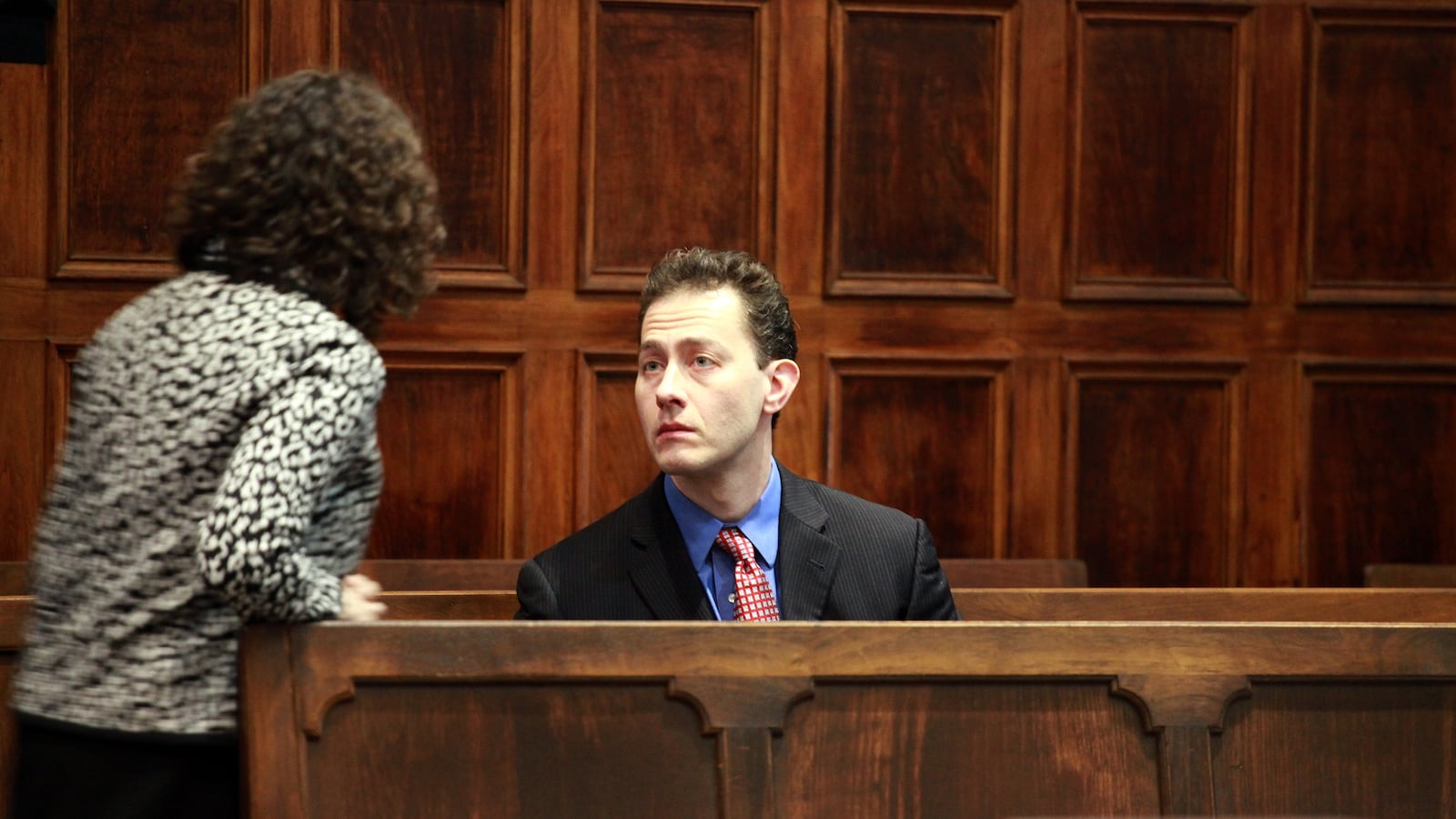Roderick Covlin only cared about three things in 2009: his many girlfriends, his professional backgammon career, and the money he was still raking in from his estranged wife, prosecutors said Tuesday at the start of his murder trial in Manhattan.
But when Shele Danishefsky, a 47-year-old UBS wealth manager, decided to cut Covlin out of her will in 2009—finalizing their divorce and severing her last financial connections to her husband—Covlin allegedly used a martial arts “chokehold” to break her neck before she could sign the papers.
“This is a murder. If this is a murder the only human on the plant with motive, means, and opportunity is sitting across from you in the courtroom,” Assistant District Attorney Matthew Bogdanos argued in his opening statement. “He is on trial for murdering the woman he hated… with all consuming anger.”
Prosecutors revealed stunning details of Danishefsky’s murder during opening arguments, describing how Covlin, 45, mentally and physically abused his wife, whom he relied on financially.
Danishefsky’s attempt to cut her unemployed husband out of her will and life “filled Covlin with all-encompassing rage,” driving him to murder, prosecutors said.
“His primary motive to kill her was pure, unadulterated greed,” Bogdanos said.
In the two-and-a-half-hour opening statement, which was deemed “outrageous” by the defense, Bogdanos detailed the year prior to Danishefsky’s murder, the evidence against Covlin, and every move he made after suggesting he had no remorse for his heinous actions.
Covlin, who wore a grey suit, sat emotionless during both the prosecution’s and the defense’s opening statements—staring at the jury the entire time.
“The prosecution is out of control. This isn’t a game. From top to bottom, the opening was a disgrace,” Covlin’s defense attorney, Robert Gottlieb, said to the judge before demanding a mistrial, which Judge Ruth Pickholz ultimately denied.
In the defense’s opening statement, Gottlieb described the case as “tragic beyond description” but insisted it was nothing more than an “accident,” as the police and the medical examiner initially concluded.
“This is what I say to you right now, just wait,” he told the jury. “Just wait. And if you wait and if each of you keeps an open mind and promises as you did when you were being questioned during jury selection, this is what you are going to see. The state’s story is wrong.”
He continued: “What you just heard for two hours reflected an outrageous and distorted version of the fact that the police were involved in this case from the beginning, and believed that Shele’s case was an accident.”
The prosecution argued the opposite to the jury of six men and six women, first describing how Danishefsky met Covlin at a Jewish singles event in 1998. Despite their 11-year age difference, the two were married in a matter of weeks at Covlin’s insistence.
Rather than pursue his own career, Bogdanos alleged, the failed stockbroker lived off his wife’s successful career and never found steady employment. Instead, Covlin spent more of his time compulsively pursuing women on social media and dating websites while pursuing a career as an amateur backgammon player.
“[Danishefsky] had a dark little secret. A secret that she kept from the world and a secret that she was ashamed about,” Bogdanos said. “That secret caught Shele her life. She was a victim of domestic violence.”
Shortly after the birth of their son Miles, Covlin got a separate email account for the sole purpose of pursuing other women, prosecutors alleged, before asking his wife for an open marriage in 2008 on their 10th wedding anniversary—which she refused.
“The evidence shows that in one day, [Covlin] asked 24 different women to have a drink with him,” Bogdanos told the jury. “He propositioned a hundred women a month, though he was not that successful. But [Covlin] had an inability to accept failure and blamed every misstep on Shele.”
Allegedly fed up, Danishefsky asked Covlin to move into a smaller apartment across the hall to make the transition easier on their two children, court papers stated.
“I feel like I am at my wits end,” Danishefsky allegedly told her sister about her relationship on Jan. 4, 2009, less than a year before she was found dead.
The pair were separated by April, though Covlin did move across the hall in their Lincoln Center apartment building. Danishefsky had the locks changed on her apartment door and obtained an order of protection.
“Despite the fact that you will hear she was deathly afraid of him, that decision represented the first step of a new life without the defendant,” the assistant district attorney said. “But that decision was also going to cost her her life.”
When the successful financier finally served her husband divorce papers, Covlin realized the steady flow of his wife’s money would cease, prosecutors said, and hacked into Danishefsky’s phone records and email counts—even breaking into her home on multiple occasions.
“Less than two days before her murder, Shele had made arrangements to change her will,” Bogdanos said. “Her murder prevented that change from taking place.”
On New Year’s Eve, two days after Danishefsky sent those emails, their 9-year-old daughter, Anna, discovered her mother’s body in the bathtub at about 7 a.m. and made what prosecutors describes as a “hysterical” 33-second call to her father before phoning the lobby of their apartment building to let them know an ambulance was coming.
When police responded to the apartment at 7:20 a.m., Covlin was leaning over his wife, who was naked and partially covered with a sheet and blanket next to a bathtub filled with bloody water.
Prosecutors say Covlin, who had been ordered by a court to stay away from his family, had a key and used it to slip in and out of his wife’s apartment between 1:00 a.m. and 4:00 a.m.
“I think that she may have grabbed a piece of wood, the wooden cabinet, and fell and hit the back of her head, and slipped under the water. I had to pull her out of the water,” Covlin told cops who arrived to Danishefsky’s apartment, according to court documents. “I was trying to revive her. I went to the bathroom and pulled her out of the tub.”
Police initially thought that Danishefsky had accidentally fallen and then drowned. Her body was buried without an autopsy at the request of her Orthodox Jewish parents.
But at the insistence of friends and family, the police continued to investigate the case and eventually found evidence of foul play. That includes the revelation that the day before her murder, Danishefsky got a keratin treatment, a chemical hair application that is ruined if exposed to water within 72 hours.
“That morning she got a keratin treatment, a straightening of her hair. A treatment that you can’t shower, bath, get your hair wet for 72 hours,” Bogdanos explained to the jury. “She had done them in the past and her hairdresser reminded her that day that she couldn’t get her hair wet.”
When Danishefsky was exhumed in March 2010, a medical examiner determined that she had died not from drowning, but rather strangling. An injury to one of her neck bones suggested that a martial arts-style “chokehold” was used during the attack.
The medical examiner also determined that Danishefsky’s own skin and blood were under her fingernails, suggesting that she was scratching her own face while Covlin—who previously told friends he “could kill someone with one hand”—strangled her, prosecutors said.
Although Covlin was always the prime suspect, it took police six years to arrest him for the murder. Prosecutors alleged in court Tuesday that Covlin spent those years scrambling to cover up his tracks and collect his dead wife’s fortune, isolating himself from his own family and children in the process.
“He viewed his children as nothing more than automatic teller machines,” Bogdanos said.
In 2015, authorities finally had enough evidence to charge Covlin with two counts of second-degree murder. If convicted at trial, he faces life in prison.
“The state does not even have proof that Shele was even murdered by anyone,” Gottlieb said. “The state does not have proof that this was anything but a horrible and tragic accident. There is no direct proof. There is no evidence of any struggle. Nothing, nothing.”
Over a dozen of Danishefsky’s family members were present in court Tuesday, occupying the first few rows of the courtroom and holding hands during both sides’ lengthy opening statements. One of the family members confirmed to The Daily Beast that “at least ten of us” will be in the courtroom room for the trial, which is expected to last two months.
“This situation is surreal. We just want Rod to be held accountable for hurting Shele in life and death,” the family member said. “He murdered her for money and now continues to hurt their children, who are only piece of Shele we have left. We won’t let him get away with hurting our family any longer.”







